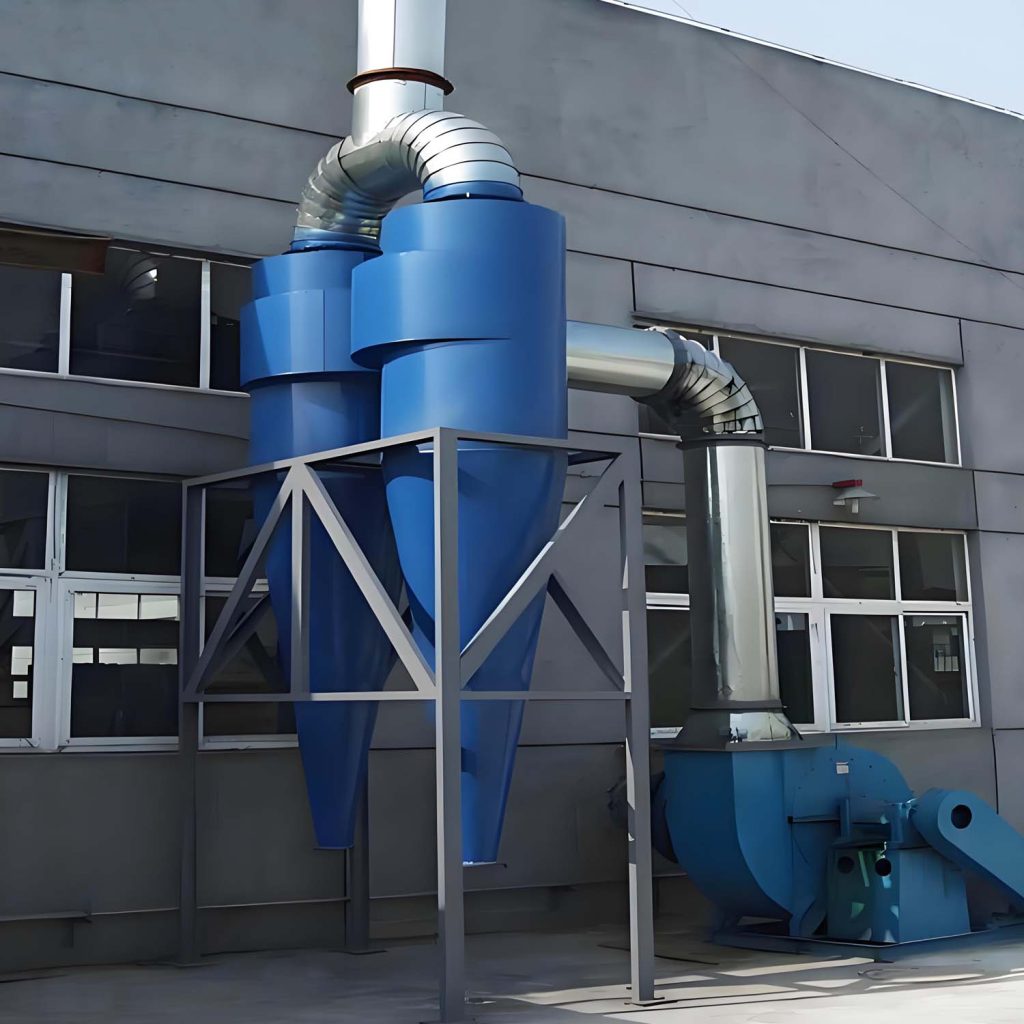Introduction: The Invisible Enemy – Combating Dust in Workshops and Factories
Dust is more than just a nuisance; it’s a pervasive adversary in workshops, factories, and manufacturing environments. From fine wood dust impairing respiratory health to hazardous metal shavings, effective dust collection isn’t optional – it’s essential for safety, equipment longevity, and product quality. Enter the cyclone dust collector – a workhorse of pre-filtration renowned for its efficiency, simplicity, and resilience. Unlike traditional bag or cartridge filters that bear the brunt of primary particle load, cyclones leverage the fundamental physics of air motion to separate dust before it ever reaches the finer filter media. This article dives deep into the mechanics, benefits, applications, and considerations surrounding cyclone dust collectors.
The Core Principle: Harnessing the Centrifugal Vortex
At the heart of every cyclone dust collector lies a deceptively simple principle: centrifugal force. Instead of relying solely on filter media for capture, a cyclone separator forces dust-laden air into a controlled spiral, effectively spinning the dust out of the airstream. Here’s the step-by-step breakdown:
- Tangential Inlet: Contaminated air enters a conical or cylindrical chamber through a tangential inlet near the top. This inlet design is crucial as it immediately imparts a powerful spinning motion (vortex) to the incoming airstream.
- High-Speed Vortex Formation: Once inside the chamber, the air is forced into a rapid, downward-spiraling vortex along the inner walls. The conical shape of most cyclones gradually decreases the diameter, which naturally intensifies the rotational speed as the air descends.
- Centrifugal Separation: As the air spins at high velocity, centrifugal force acts upon the dust particles suspended within it. This force throws the denser, heavier particles radially outward towards the chamber walls. Larger, heavier particles are separated earliest and most effectively.
- Boundary Layer & Descent: The outer layer of the spinning vortex, carrying the concentrated dust particles, travels down the cone’s walls. Friction and gravity cause these particles to lose momentum and fall away from the main air stream.
- Dust Collection: The separated dust particles slide down the chamber walls and accumulate in a collection bin or drum located directly underneath the cyclone cone.
- Air Reversal & Exit: Cleaned air, now largely devoid of the bulkier particles, reverses direction at the bottom of the cone. This cleaner air forms a smaller, inner vortex that spirals upwards through the center of the cyclone.
- Vortex Finder & Outlet: The ascending inner vortex of cleaner air exits the chamber through a central tube called the vortex finder or exhaust tube, located at the very top of the cyclone. This air is then typically routed to a secondary filter (like a bag or cartridge) to capture any remaining fines before being exhausted or recirculated.
Why Choose a Cyclone? Key Advantages
Cyclone pre-separators offer compelling benefits over systems relying solely on primary filters:
- Dramatic Filter Life Extension: This is often the primary reason for choosing a cyclone. By removing 80-99% of the dust before it reaches the primary filter (especially the heavier, coarser particles), the filter stays cleaner for vastly longer periods. This translates to significantly reduced filter replacement costs and less frequent cleaning downtime.
- Superior Efficiency for Coarse Particles: Cyclones excel at capturing chips, shavings, larger sawdust, and other high-volume debris common in woodworking, metalworking, and recycling. They handle these abrasive materials efficiently without degrading.
- Low Maintenance (Collection Bin): Emptying a solid collection bin or drum is a simple, quick, and clean task compared to replacing or thoroughly cleaning clogged filter media. No filter bags to tear or shake.
- Reduced Fire Risk: By quickly separating sparks and hot embers (common in metal grinding or some woodworking) into a grounded metal collection bin filled with dust (which acts as an insulator), cyclones significantly reduce the risk of these ignition sources reaching the primary filter where fine, combustible dust accumulates.
- Handles High Volumes & Heavy Loads: Cyclone designs are inherently robust. They can manage large volumes of air (high CFM – Cubic Feet per Minute) and significant quantities of heavy debris without choking, making them ideal for high-production environments.
- Cost-Effective Operation: While the initial investment might be higher than a basic single-stage collector, the long-term savings on filter replacements (and potentially electricity if blowers run more efficiently against cleaner filters) often make cyclones the more economical choice over time.

Anatomy of a Cyclone System: Beyond the Cone
A complete cyclone dust collector system involves more than just the cyclone body:
- Cyclone Separator Body: The core conical/cylindrical component where particle separation occurs. Design details like inlet size/shape, cone angle, barrel height, and vortex finder dimensions are critical for efficiency.
- Inlet Ducting: Brings contaminated air from machinery to the cyclone. Proper sizing (diameter) minimizes static pressure loss.
- Dust Collection Bin/Drum: Located directly under the cyclone outlet. Needs to be air-tight and easily removable for emptying. Clear bins are popular for visibility. Includes a gasket/seal at the top.
- Blower/Motor: Provides the suction power. Mounted after the cyclone (pulling air through it) is generally preferred for protecting the fan from debris, though some smaller units might use a push configuration. Impeller design and motor HP dictate CFM/SP capabilities.
- Secondary Filter Housing: Contains the fine filter media (pleated cartridge, bag filters, HEPA filters) to capture the dust particles the cyclone misses (typically very fine dust).
- Clean Air Outlet/Ducting: Vents the cleaned air outside or recirculates it back into the space after passing through the secondary filter.
- Mounting Hardware: Secure brackets or stands for stable installation.
- Optional: Accessories like bin-full sensors, explosion vents (for hazardous dusts), sound insulation, and different inlet/outlet adapters.
Applications: Where Cyclones Shine
Cyclone dust collectors are versatile and find application wherever significant coarse dust, chips, or shavings are generated:
- Woodworking: Sawdust (especially from planers, jointers, table saws, routers, sanders), wood chips, shavings. Extremely common in cabinet shops and furniture factories.
- Metalworking: Grinding swarf, machining chips (steel, aluminum, brass), metal turnings, filings. Protects filters from abrasive particles.
- Plastics Manufacturing: Plastic chips, shavings, regrind from routing, milling, and drilling operations.
- Recycling Facilities: Pre-separating contaminants or segregating different types of shredded materials.
- Agriculture: Grain handling dust, chaff separation.
- Powder & Bulk Handling: Pre-cleaning air before very fine filtration.
- DIY Workshops: Increasingly popular for home shops handling woodworking or light metalwork.
Cyclone Types: DIY to Industrial
- Commercial Single Cyclone Units: The most common configuration, typically mounted atop a collection barrel. Offers excellent pre-separation for a wide range of applications. Examples include units like those from Oneida, ClearVue, Grizzly, and Laguna. Sizes range from compact (1-2HP) for small shops to large (5HP+) industrial units.
- Cyclone Central Systems: Large cyclones serve as the “hub” for extensive ductwork networks feeding multiple machines in a large shop. Requires careful duct sizing and blast gates.
- Multi-Cyclone (Pentagonal/Hexagonal): Some designs incorporate multiple small cyclones arranged in a pattern within a housing (e.g., some shop vacs or small collectors). Aim for efficiency in a compact space but generally less effective for large chips than a well-designed large single cyclone.
- Thein Baffle (DIY Cyclone): A popular, effective DIY design using a flat baffle plate inside a separator bucket to create a vortex. Simpler to build than a true cone cyclone but offers surprisingly good separation for hobbyists.
Important Considerations & Limitations
While powerful, cyclones aren’t a universal panacea:
- Fine Dust Capture: Cyclones are primarily pre-separators. They are significantly less efficient at capturing very fine dust particles (often below 5-10 microns), especially those lighter than air. A secondary fine filter is ALWAYS mandatory to capture these respirable particles for health and safety.
- Static Pressure Drop: The cyclone body itself creates resistance to airflow (static pressure, SP). The blower motor must be sized to overcome this resistance plus the resistance of the ducting and secondary filters to maintain adequate CFM at the tool.
- Space Requirements: Cyclones and their collection barrels take up significant floor space, especially central systems.
- Initial Investment: Higher upfront cost compared to basic single-stage bag collectors.
- Design Sensitivity: Efficiency is highly dependent on precise geometry. Poorly designed cyclones (e.g., incorrect cone angles, oversized inlets) can suffer from re-entrainment (dust escaping back into the air stream) and low separation efficiency.
- Abrasive Dust: While cyclones handle abrasive dust well inside, the inlet and cone itself can suffer wear. Abrasion-resistant liners or designs are sometimes necessary.
Optimizing Your Cyclone System
- Sizing is Paramount: Match the cyclone and blower (HP, CFM, SP) to your dust volume, particle size, duct run lengths, and number of tools open simultaneously. Undersized systems are ineffective.
- Ducting Design: Use smooth-walled spiral pipe (metal or PVC), minimize hose lengths, avoid sharp bends (use sweeps), ensure adequate pipe diameter. Follow “Airflow 101” principles.
- Air-Tight Seals: Leaks anywhere (cyclone body joints, bin lid, duct connections) drastically reduce performance. Use good gaskets and sealant.
- Empty the Bin Regularly: Don’t let dust build up high enough to interfere with the inlet stream or get pulled back into the airflow.
- Maintain Secondary Filters: Clean or replace them as scheduled based on pressure drop, not just visual inspection. A clean secondary filter ensures the blower can pull sufficient CFM.
The Future of Cyclones
While the core principle remains timeless, innovation continues: * Advanced Computational Fluid Dynamics (CFD): Allows for optimizing designs for specific particle profiles and flow rates. * Material Improvements: More durable and abrasion-resistant coatings for severe service. * Integrated Monitoring: Sensor systems for bin-full detection, pressure drop across cyclone and filters, and even air quality sensing. * Compact & Modular Designs: Further tailoring for space-constrained or niche applications.
Conclusion: A Cornerstone of Efficient Dust Management
The cyclone dust collector stands as a testament to the power of elegant engineering applied to a fundamental industrial challenge. By harnessing the physics of centrifugal force, it dramatically lightens the load on expensive filter media, enhances fire safety, and excels at handling the high-volume debris common in many trades. While not a standalone solution – always requiring a secondary filter – its role as a pre-separator is invaluable. For woodshops buzzing with activity, metalworking facilities grinding away, or any environment generating significant coarse dust, incorporating a well-designed cyclone dust collector is an investment in cleaner air, longer-lasting equipment, lower operational costs, and ultimately, a healthier, safer, and more productive workplace. Mastering air filtration begins with mastering the vortex – the core principle of the indispensable cyclone.

